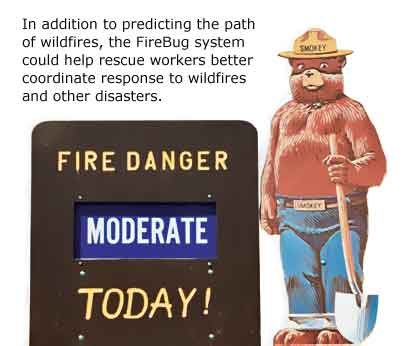Apr 01, 2005Smokey the Bear has a new friend in the battle to keep our forests safe. While only you can prevent wildfires, wireless sensor networks can help contain them.
A new creature called the FireBug is helping firefighters out West battle wildfires. Researchers at the University of California, Berkeley, have developed the FireBug-a GPS-enabled wireless thermal sensor that gathers real-time data from approaching wildfires-to predict the path of destruction, protect people and homes, and keep firefighters out of harm's way.
FireBugs are environmental sensor motes, which monitor temperature, humidity, barometric pressure and light intensity. Each mote runs the TinyOS operating system and uses radio communications to send data to other motes. The motes are networked into "sensor nets" to provide comprehensive real-time data on the environment to a base station. That data is then relayed to a database server and on to a Web browser system so that it can be monitored online.
A team of Berkeley researchers-nearly all of whom have received fire-safety training-has been testing the FireBug system during controlled burns in the San Francisco Bay area since September, and they have reported considerable success. Sensors from the burn zone communicated that temperatures increased and barometric pressure and humidity decreased as the wall of flames approached, indicating that local environment conditions change during fires. The rate of change may indicate the amount of danger and the speed at which the danger is increasing.
The researchers need to resolve some liability and technical issues before testing the FireBugs in real wildfires. They do see potential for deployment in fire departments out West, but acknowledge that a commercial provider or government would have to foot the bill for manufacturing.
In addition to predicting the path of wildfires, the FireBug system could help rescue workers better coordinate response to wildfires and other disasters. "One of the things that came out of the series of wildfires and urban fires here in California-even before 9/11-was the importance of the coordination of where people were in terms of firefighting personnel," says Nicholas Sitar, a professor at Berkeley's department of civil and environmental engineering and one of the FireBug researchers. "Where people were deployed and knowing where the fires were going was a big management issue. A lot had to do with having enough objective local information to make decisions."
What becomes of the FireBugs in a blaze? "The sensors are disposable and inexpensive," says Sitar. "Our initial idea was that the moment they burn up, we know where the fire is." But after researchers underwent fire training, Sitar says, they realized that FireBugs could also be used to pinpoint the location of personnel in the field: "We're now looking at having a personal sensor on each firefighter."

